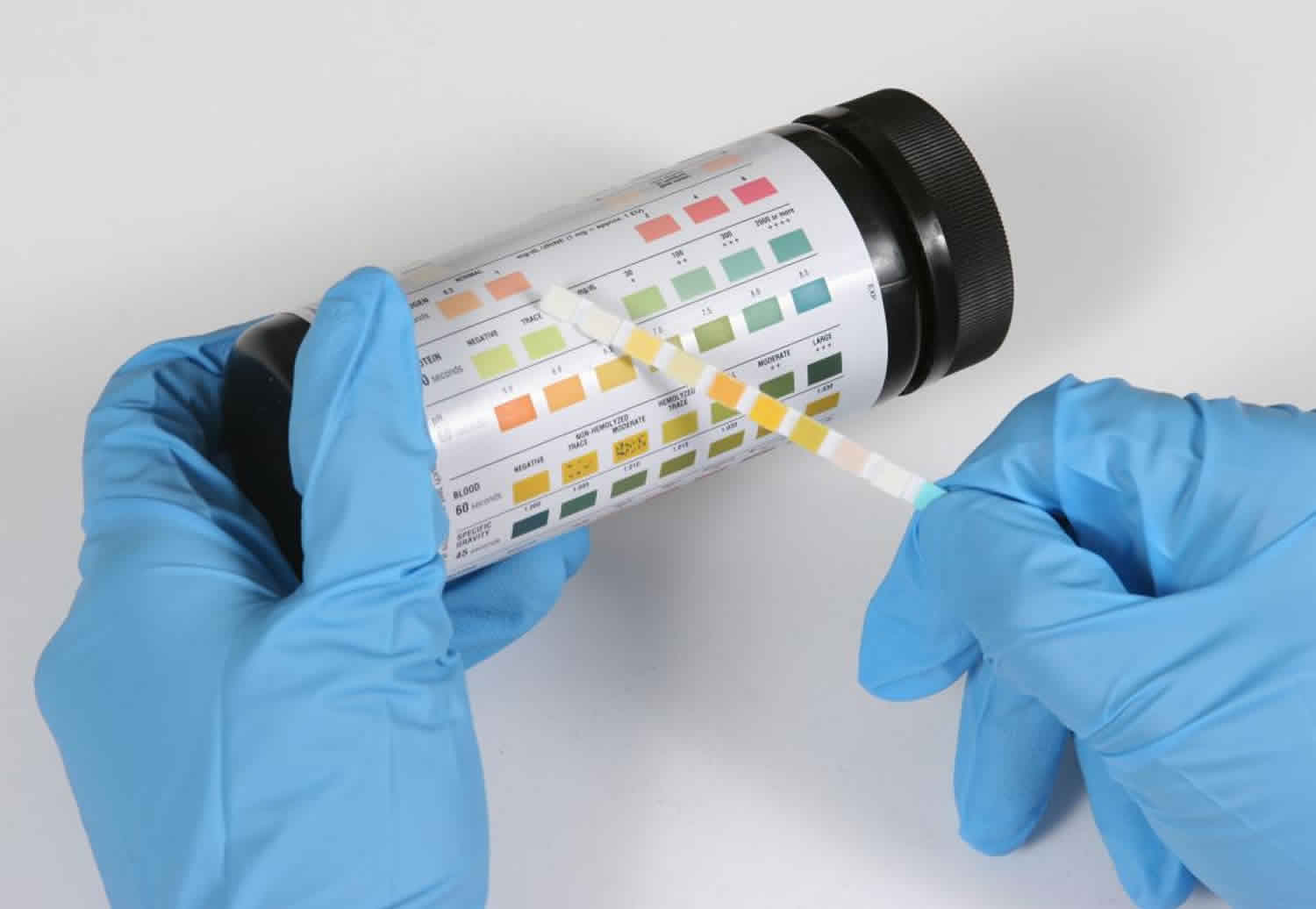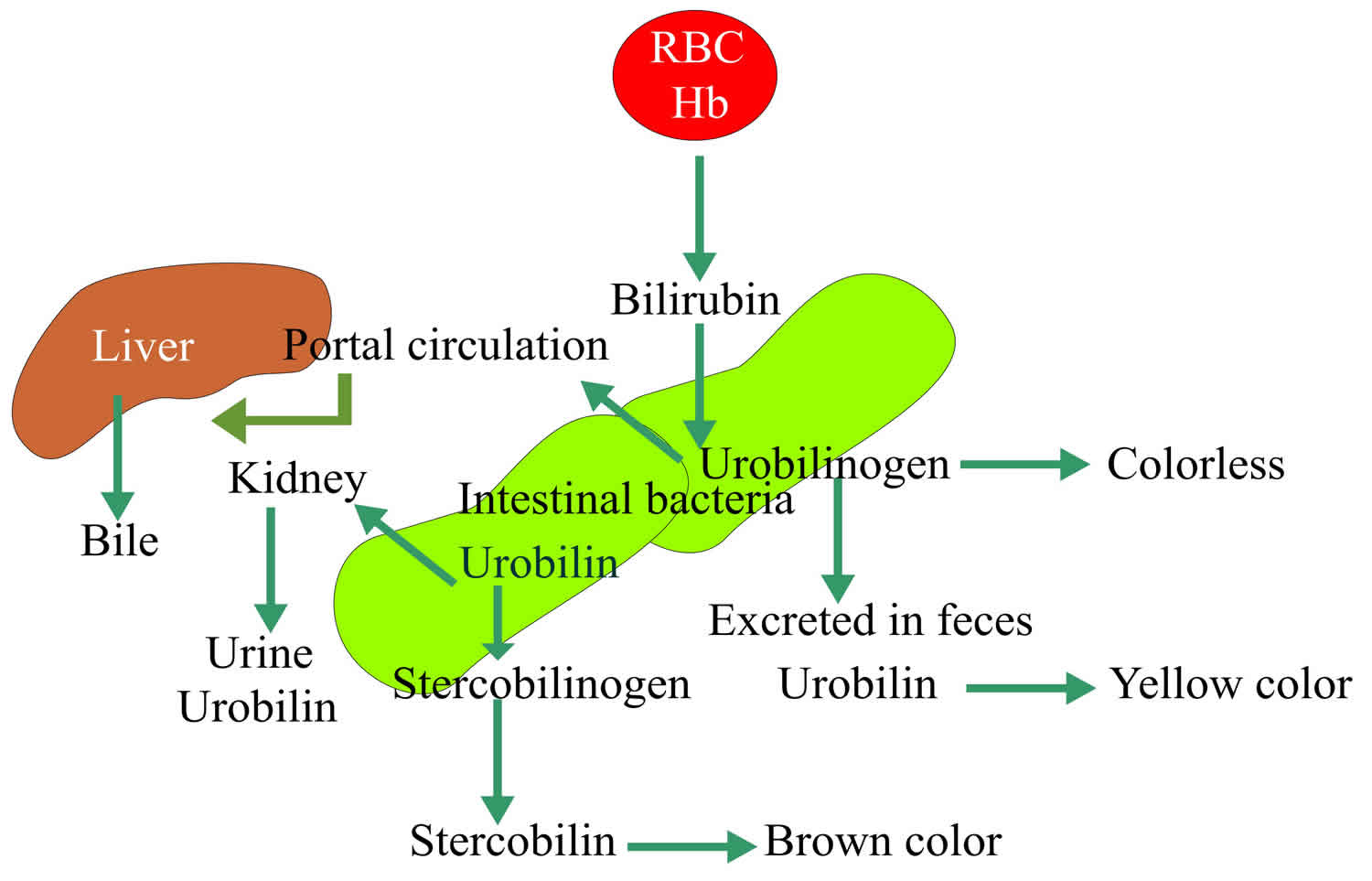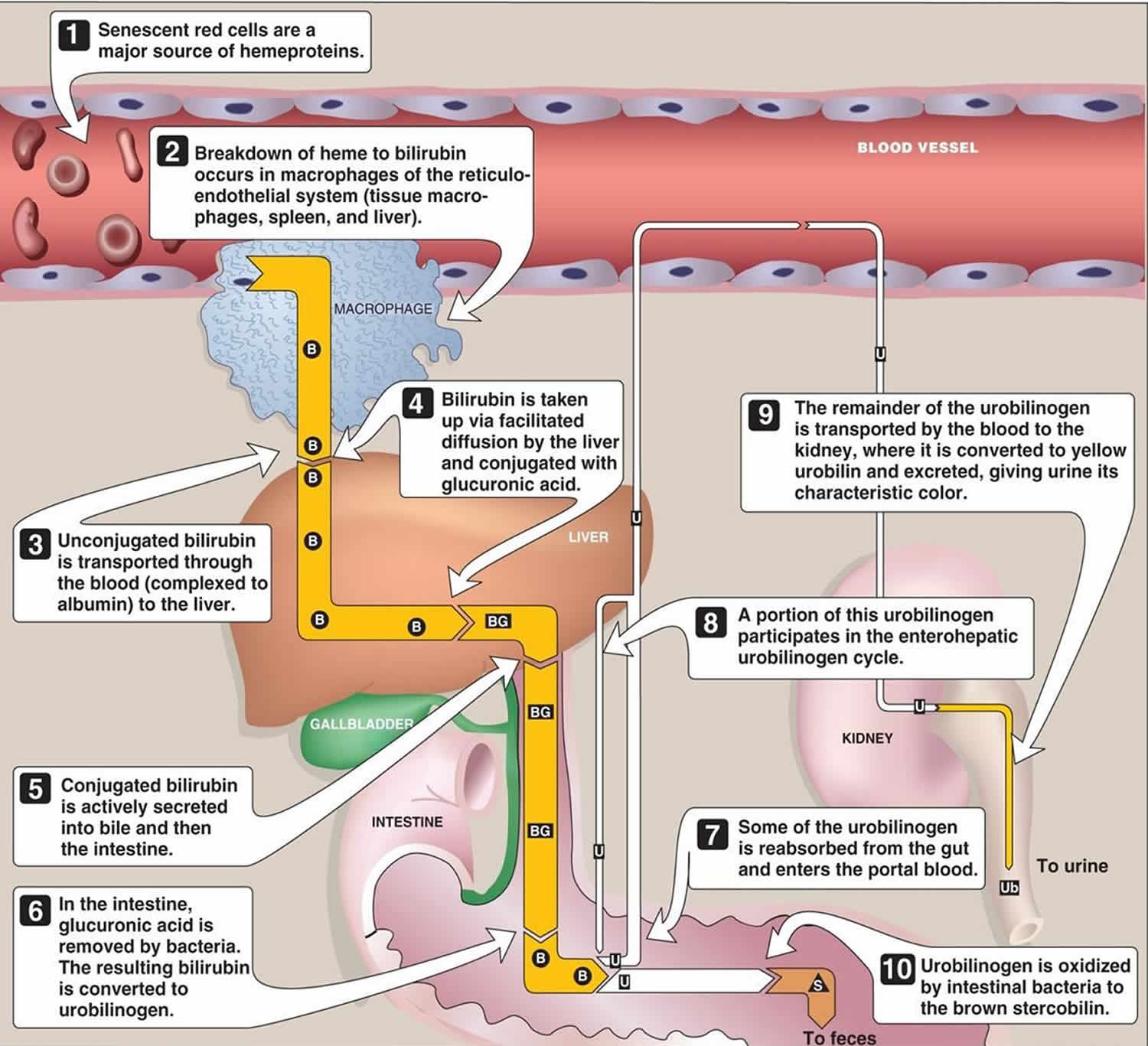What is urobilinogen
Urobilinogen is formed from the reduction of bilirubin. Urobilinogen is normally present in urine in low concentrations. Urobilinogen is formed in the intestine from conjugated bilirubin, and a portion of it is absorbed back into the blood. Positive urine urobilinogen test results may indicate liver diseases such as viral hepatitis, cirrhosis, liver damage due to drugs or toxic substances, or conditions associated with increased red blood cell destruction (hemolytic anemia). When urine urobilinogen is low or absent in a person with urine bilirubin and/or signs of liver dysfunction, it can indicate the presence of hepatic or biliary obstruction.
Bilirubin is derived from two main sources, and about 4 mg/kg body weight of bilirubin is produced daily 1. Roughly, seventy percent to 90% of bilirubin is derived from the breakdown of hemoglobin in old red blood cells (red blood cells heme) and prematurely destroyed erythroid cells in the bone marrow. The remainder originates from the turnover of various heme-containing proteins found in other tissues, primarily the liver and muscles. These proteins include myoglobin, cytochromes, catalase, peroxidase, and tryptophan pyrrolase. Bilirubin is an important metabolite of heme (ferroprotoporphyrin IX) and bilirubin is a potentially toxic substance. Red blood cell breakdown produces unconjugated (or ‘indirect’) bilirubin, which is mostly bound to albumin. Unconjugated bilirubin (indirect bilirubin) is metabolized in the liver to produce conjugated (or ‘direct’) bilirubin or bilirubin diglucuronide, which is water soluble for easier transport. Conjugated (or ‘direct’) bilirubin then passes through the gut and is excreted in the stool. Bilirubin can be reabsorbed again from stools remaining in the gut. When the conjugated bilirubin reaches the distal ileum and colon, it is rapidly reduced and deconjugated by colonic flora to a series of molecules termed urobilinogen. The major urobilinoids seen in stool are known as urobilinogen and stercobilinogen, nature and relative proportion of which will depend on the presence and composition of the gut bacterial flora. These substances are colorless but turn orange-yellow after oxidation to urobilin, giving stool its distinctive color.
The process of bilirubin conjugation alters the physiochemical properties of bilirubin giving it many special properties. Most importantly, it makes the bilirubin water soluble which allows it to be transported in bile without a protein carrier 1. Conjugation also increases the size of the bilirubin molecule. Conjugation prevents bilirubin from passively being reabsorbed by the intestinal mucosa due to its hydrophilicity and large molecular size. Thus, conjugation works to promote the elimination of potentially toxic bilirubin metabolic waste products. Furthermore, conjugation modestly decreases the affinity of bilirubin for albumin.
Figure 1. Urobilinogen production and excretion
Liver bilirubin conjugation
Conjugation is mandatory to render bilirubin aqueous soluble and facilitate its secretion across the canalicular membrane and excretion into bile. Bilirubin is conjugated within the hepatocyte to glucuronic acid by a family of enzymes, termed uridine-diphosphoglucuronic glucuronosyltransferase (UDPGT). The process of glucuronidation is one of the many crucial detoxification mechanisms of the human body. Many different isoforms of uridine-diphosphoglucuronic glucuronosyltransferase (UDPGT) exist, but the physiologically important isoform in bilirubin glucuronidation is UDPGT1A1. The enzyme esterifies two glucuronide moieties to the propionic acid side chains of bilirubin. Under normal conditions, bilirubin diglucuronide is the predominant molecule synthesized. However, if the conjugation system is overwhelmed under conditions of excessive bilirubin synthesis, the majority of bilirubin may be conjugated as bilirubin monoglucuronide. The ratio of mono-conjugated to the dis-conjugated pigment in bile is 1:4 1. Conjugation of bilirubin to the water-soluble form involves the disruption of the hydrogen bonds, an essential process for its elimination by the liver and kidney. This is achieved by glucuronic acid conjugation of the propionic acid side chains of bilirubin.
Excretion of conjugated bile
Conjugated bilirubin (direct bilirubin) and other substances destined to be excreted in bile are actively transported across the bile canalicular membrane of the liver cell (hepatocyte). The concentration gradient is very high and can reach 1:1000 1. There are at least four known canalicular transporters that participate in excretion of conjugated bilirubin. However, the multidrug resistance-associated protein 2 (MRP2) appears to play the dominant role in the canalicular secretion of conjugated bilirubin. A portion of conjugated bilirubin is transported into the sinusoids and portal circulation by MRP3, which can undergo hepatocyte reuptake via the sinusoidal proteins, organic anion transport protein 1B1 and 1B3 (OATP1B1 and OATP1B3). Thus some conjugated and unconjugated bilirubin may escape the hepatocyte cytosol into the plasma where it binds to albumin and gets transported around the body. However, only conjugated bilirubin can enter the bile. The conjugated bilirubin is then actively secreted into canalicular bile, and drains into the small intestine. The rate-limiting step in bilirubin throughput is the hepatic excretory capacity of conjugated bilirubin. Part of the conjugated bilirubin may accumulate in serum when the hepatic excretion of the conjugated bilirubin is impaired as in prolonged biliary obstruction or intrahepatic cholestasis 1. This fraction of conjugated bilirubin gets covalently bound to albumin, and is called delta bilirubin or delta fraction or biliprotein 1. As the delta bilirubin is bound to albumin, its clearance from serum takes about 12-14 days (equivalent to the half-life of albumin) in contrast to the usual 2 to 4 hours (half-life of bilirubin) 1.
Degradation of conjugated bilirubin in the digestive tract
Conjugated bilirubin (direct bilirubin) is not reabsorbed from the proximal intestine; in comparison, unconjugated bilirubin (indirect bilirubin) is partially reabsorbed across the lipid membrane of the small intestinal epithelium and undergoes enterohepatic circulation 1. Within the proximal small intestine, there is no additional metabolism of bilirubin, and very little deconjugation takes place. In stark contrast, when the conjugated bilirubin reaches the distal ileum and colon, it is rapidly reduced and deconjugated by colonic flora to a series of molecules termed urobilinogen. The major urobilinoids seen in stool are known as urobilinogen and stercobilinogen, nature and relative proportion of which will depend on the presence and composition of the gut bacterial flora. These substances are colorless but turn orange-yellow after oxidation to urobilin, giving stool its distinctive color.
As unconjugated bilirubin (indirect bilirubin) is always bound to albumin in serum, it cannot be filtered by the glomeruli (in the absence of glomerular disease). Thus, unconjugated bilirubin is never found in urine even when there is an elevated level of unconjugated bilirubin in circulation. Jaundice that occurs with unconjugated hyperbilirubinemia is termed acholuric because the urine is not darkened 1.
Dark urine, however, occurs when there is excretion of an excess of water-soluble, conjugated bilirubin. This is seen in conjugated hyperbilirubinemia and signifies the presence of either liver or biliary disease. Thus the presence of urobilinogen (bilirubin in urine) will help identify subtle hepatobiliary dysfunction leading to conjugated hyperbilirubinemia, even when the measured concentration of conjugated bilirubin is serum is only slightly elevated. An exception to this rule is when bilirubinuria is not detected in a patient with prolonged cholestasis and marked jaundice. This is due to the formation of delta bilirubin or conjugated bilirubin that is tightly bound to serum albumin. The absence of bilirubinuria in such patients should not cause any difficulty in diagnosing conjugated hyperbilirubinemia, as the patient is clearly jaundiced and serum conjugated bilirubin is markedly elevated in such cases.
What is urobilinogen in urine?
Your health care provider may have ordered urobilinogen in urine test as part of your regular checkup, to monitor an existing liver condition, or if you have symptoms of a liver disease. These include:
- Jaundice, a condition that causes your skin and eyes to turn yellow
- Nausea and/or vomiting
- Dark colored urine
- Pain and swelling in the abdomen
- Itchy skin
What does urobilinogen positive means?
If your urobilinogen in urine test results show a higher-than-normal level of urobilinogen, it may indicate:
- Hepatitis
- Cirrhosis
- Liver damage due to drugs
- Hemolytic anemia, a condition in which red blood cells are destroyed before they can be replaced. This leaves the body without enough healthy red blood cells
If your results are abnormal, it does not necessarily indicate you have a medical condition requiring treatment. Be sure to tell your health care provider about any medicines and supplements you are taking, as these can affect your results. If you are a woman, you should tell your health care provider if you are menstruating.
Urobilinogen in urine test is only one measure of liver function. If your health care provider thinks you might have a liver disease, additional urine and blood tests may be ordered.
What does urobilinogen negative or low urobilinogen means?
If your urobilinogen in urine test results show too little or no urobilinogen in your urine, it may indicate:
- A blockage in the structures that carry bile from your liver
- A blockage in the blood flow of the liver
- A problem with liver function
Urobilinogen in urine test is only one measure of liver function. If your health care provider thinks you might have a liver disease, additional urine and blood tests may be ordered.
References






